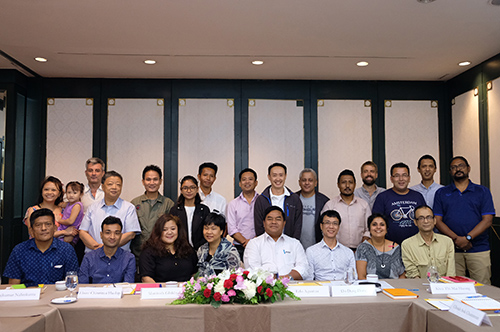“Achievements, Lessons Learned, and Ways Forward on Hepatitis C Diagnosis and Treatment Access” was the title of the annual regional strategic meeting on hepatitis C advocacy, hosted by TREAT Asia in Bangkok, August 23−24. The consultation brought together 25 treatment advocates and civil society representatives from eight countries and key population regional networks, as well as from the Médecins Sans Frontières Access Campaign.

Participants at the regional consultation, “Achievements, Lessons Learned, and Ways Forward on Hepatitis C Diagnosis and Treatment Access,” August 23–24, 2018, Bangkok, Thailand
The consultation examined progress on implementation of national hepatitis C programs and global policy development, along with challenges to improving regional hepatitis C diagnosis and treatment access. The objectives were to identify priority areas for technical support to national partners and where strategic collaborative efforts should be focused to achieve successful advocacy outcomes.
“Although there have been rapid developments in policies and availability of medicines, major challenges still exist, including low levels of understanding around hepatitis C cure among patients, high medicine pricing, and lack of uptake of the direct-acting antivirals (DAAs) in national programs,” says Giten Khwairakpam, TREAT Asia’s Program Manager for Community and Policy. “It is important to keep civil society informed and to work collectively to address continuing problems.”

(Left to right) Elaine Chinrimoi Haokip and Manitosh Ghildiyal, Delhi Network of Positive People (DNP+), India; Edo Agustian, Persaudaraan Korban NAPZA Indonesia/Indonesian Drug Users Network (PKNI), Indonesia.
Participants reviewed the history of access to hepatitis C medicines and considered developments since DAAs became available, including the swiftly evolving treatment guidelines from the World Health Organization, most recently updated in July 2018. They voiced concerns around inconsistent pricing of DAAs across the region, delays in national regulatory approvals of medicines, and an emerging lack of competition among generic pharmaceutical companies supplying these medicines. Since there is usually one or very few companies approved to sell their DAAs in any given country, there is less incentive to bring wholesale prices down.
The consultation also provided a forum to discuss concerns about declining investments in HIV treatment education for people living with HIV; advocates reported that external donor funding for this is now almost nonexistent in some countries. Without these investments, national HIV programs may face greater challenges to motivate people to get HIV tested, and for those with HIV to start and stay on their antiretroviral medicines.
Although there have been rapid developments in policies and availability of medicines, major challenges still exist.“The speed with which both HIV and hepatitis C treatment policies are evolving, and DAAs or newer HIV medications like dolutegravir are becoming available in the Asia-Pacific region, is not being matched by campaigns to increase patient awareness and knowledge,” says Mr. Khwairakpam. “While policies are increasingly supportive and newer medications are reaching the developing world faster, we are not seeing the investments needed to improve treatment preparedness and education to ensure long-term gains.”
The consultation participants agreed to work on mobilizing key populations around increasing community understanding of hepatitis C, address inconsistencies in pricing with WHO’s regional and national offices, share information around successes and challenges in achieving hepatitis C treatment scale-up through a regional newsletter, and expand advocacy activities to increase awareness and access to newer HIV and TB medications.